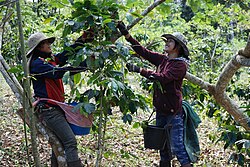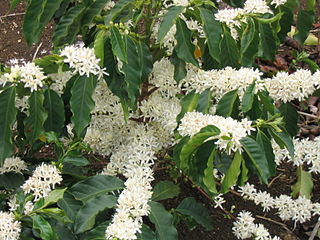
Coffea arabica, also known as the Arabica coffee, is a species of flowering plant in the coffee and madder family Rubiaceae. It is believed to be the first species of coffee to have been cultivated and is the dominant cultivar, representing about 60% of global production. Coffee produced from the less acidic, more bitter, and more highly caffeinated robusta bean makes up most of the remaining coffee production. The natural populations of Coffea arabica are restricted to the forests of South Ethiopia and Yemen.
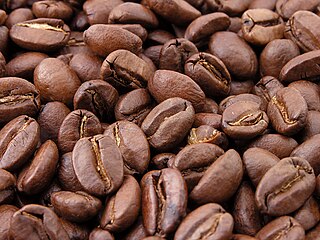
A coffee bean is a seed from the Coffea plant and the source for coffee. It is the pit inside the red or purple fruit. This fruit is often referred to as a coffee cherry, and like the cherry, it is a fruit with a pit. Even though the coffee beans are not technically beans, they are referred to as such because of their resemblance to true beans. The fruits most commonly contain two stones with their flat sides together. A small percentage of cherries contain a single seed, called a "peaberry". Peaberries make up only around 10% to 15% of all coffee beans. It is a fairly common belief that they have more flavour than normal coffee beans. Like Brazil nuts and white rice, coffee beans consist mostly of endosperm.
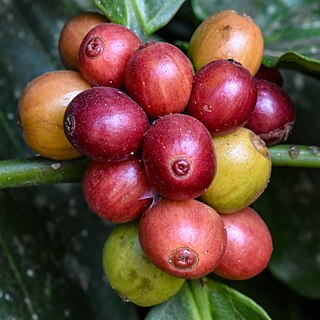
Coffea canephora is a species of coffee plant that has its origins in central and western sub-Saharan Africa. It is a species of flowering plant in the family Rubiaceae. Though widely known as Coffea robusta, the plant is scientifically identified as Coffea canephora, which has two main varieties, robusta and nganda.
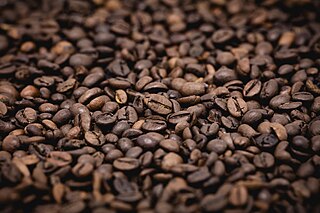
Coffee is a popular beverage and an important commodity. Tens of millions of small producers in developing countries make their living growing coffee. Over 2.25 billion cups of coffee are consumed in the world daily. Over 90 percent of coffee production takes place in developing countries — mainly South America — while consumption happens primarily in industrialized economies. There are 25 million small producers who rely on coffee for a living worldwide. In Brazil, where almost a third of the world's coffee is produced, over five million people are employed in the cultivation and harvesting of over three billion coffee plants; it is a more labor-intensive culture than alternative cultures of the same regions, such as sugar cane or cattle, as its cultivation is not automated, requiring frequent human attention.
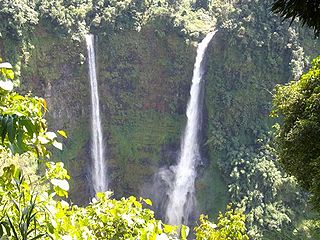
The Bolaven Plateau is an elevated region in southern Laos. Most of the plateau is located within Champasak Province of Laos, though the edges of the plateau are also located in Salavan, Sekong and Attapeu Provinces. It is located between the Annamite Range, along which runs Laos' eastern border with Vietnam, and the Mekong River to the west, at about 15°N106°E. The plateau's elevation ranges approximately from 1,000 to 1,350 metres above sea level. The plateau is crossed by several rivers and has many scenic waterfalls. The name Bolaven makes reference to the Laven ethnic group which has historically dominated the region. However, domestic migrations by the Lao ethnic group has resulted in widespread interethnic marriage, thus modifying the ethnic composition of the region.

The southeast Asian country of Laos, with a landmass of 23.68 million hectares, has at least 5 million hectares of land suitable for cultivation. Seventeen percent of this land area is actually cultivated, less than 4 percent of the total area.
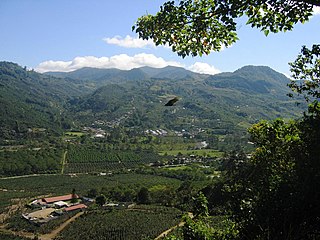
Coffee production has played a key role in Costa Rica's history and continues to be important to the country's economy. In 2006, coffee was Costa Rica's number three export, after being the number one cash crop export for several decades. In 1997, the agriculture sector employed 28 percent of the labor force and comprised 20 percent of Costa Rica's total GNP. Production increased from 158,000 tons in 1988 to 168,000 tons in 1992. The largest growing areas are in the provinces of San José, Alajuela, Heredia, Puntarenas, and Cartago. The coffee is exported to other countries in the world and is also exported to cities in Costa Rica.

Coffee production has been a major source of income for Vietnam since the early 20th century. First introduced by the French in 1857, the Vietnamese coffee industry developed through the plantation system, becoming a major economic force in the country. After an interruption during and immediately following the Vietnam War, production rose once again after Đổi mới economic reforms, making coffee second only to rice in value of agricultural products exported from Vietnam.

Indonesia was the fourth-largest producer of coffee in the world in 2014. Coffee cultivation in Indonesia began in the late 1600s and early 1700s, in the early Dutch colonial period, and has played an important part in the growth of the country. Indonesia is geographically and climatologically well-suited for coffee plantations, near the equator and with numerous interior mountainous regions on its main islands, creating well-suited microclimates for the growth and production of coffee.

Coffee production in India is dominated in the hill tracts of South Indian states, with Karnataka accounting for 71%, followed by Kerala with 21% and Tamil Nadu. Indian coffee is said to be the finest coffee grown in the shade rather than direct sunlight anywhere in the world. There are about 250,000 coffee growers in the country; 98% of them are small growers. As of 2009, Indian coffee made up just 4.5% of the global production, being the 7th largest producer of coffee. Almost 80% of Indian coffee is exported; 70% is bound for Germany, Russia, Spain, Belgium, Libya, Poland, Jordan, Malaysia, U.S.A, Slovenia and Austria. Italy accounts for 20.37% of the exports. Most of the export is shipped through the Suez Canal.

Coffee is an important agricultural product in the Philippines, and is one of the Philippines' most important export products aside from being in high demand in the country's local consumer market.
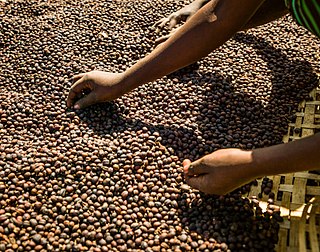
Coffee production in Ethiopia is a longstanding tradition which dates back dozens of centuries. Ethiopia is where Coffea arabica, the coffee plant, originates. The plant is now grown in various parts of the world; Ethiopia itself accounts for around 17% of the global coffee market. Coffee is important to the economy of Ethiopia; around 30-35% of foreign income comes from coffee, with an estimated 15 million of the population relying on some aspect of coffee production for their livelihood. In 2013, coffee exports brought in $300 million, equivalent to 24% of that year's total exports.

Coffee production in Tanzania is a significant aspect of its economy as it is Tanzania's largest export crop. Tanzanian coffee production averages between 30,000 and 40,000 metric tons annually of which approximately 70% is Arabica and 30% is Robusta.

Salavan is a province of Laos, located in the south of the country. Its earlier name was Saravan which was changed by the Thais to Salavan in 1828. It was part of the Champasak Kingdom in an area known as Muang Mang inhabited by minorities of Mon-Khmer groups.

Coffee is Uganda's top-earning export crop. In 1989 Uganda's coffee production capacity exceeded its quota of 2.3 million bags, but export volumes were still diminished by economic and security problems, and large amounts of coffee beans were still being smuggled out of Uganda for sale in neighbouring countries. Uganda is one of the few countries in the world with indigenous coffee, with Robusta coffee growing wild around Lake Victoria.

Coffee has been grown in Cuba since the mid-18th century. Boosted by French farmers fleeing the revolution in Haiti, coffee farms expanded from the western plains to the nearby mountain ranges. Coffee production in eastern Cuba significantly increased during the 19th and early 20th centuries. At its peak production, Cuba exported more than 20,000 metric tons of coffee beans per year in the mid-1950s. After the Cuban Revolution and the nationalization of the coffee industry, coffee production slowly began to decline until it reached all time lows during the Great Recession. Once a major Cuban export, it now makes up an insignificant portion of Cuban trade. By the 21st century, 92 percent of the country's coffee was grown in area of the Sierra Maestra mountains. All Cuban coffee is exported by Cubaexport, which pays regulated prices to coffee growers and processors.

Coffee production in Democratic Republic of the Congo (DRC) is centered in the Lake Kivu provinces. There are about 11,000 coffee farmers in the country who produce two main species of coffee, Robusta and Arabica.

Coffee production is very important for the economy of Cameroon The crop is grown extensively in the country, with robusta more prevalent in the coastal areas and arabica more widespread in the western highlands. The two varieties of arabica cultivated are Java and Jamaïca of which only Java is resistant to pests such as coffee berry disease and rust. In 2014, Cameroon was ranked the 31st largest producer of coffee in world.

Thailand is one of the top 25 coffee producers in the world as of 2014, but its status as a coffee origin has not been widely known. Thailand traditionally produced mainly Robusta for industrial use, but the country has quickly become an exciting emerging origin for specialty Arabica and fine Robusta coffees. The origin is unique in that it exports very little coffee and most of the consumption remains in the country. There is a booming specialty coffee ecosystem where farmers, roasters, cafes and consumers symbiotically co-exist. It is often seen as an example of a working coffee ecosystem for an origin where coffee produced is sustainable from both economic and environmental perspectives.
Benguet coffee, also known as Benguet arabica, is a single-origin coffee varietal grown in the Cordillera highlands of the northern Philippines since the 19th century. It belongs to the species Coffea arabica, of the Typica variety. It is one of the main crops of farmers in the province of Benguet, which has a climate highly suitable for arabica cultivation. Benguet coffee is listed in the Ark of Taste international catalogue of endangered heritage foods by the Slow Food movement.
